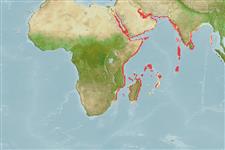分类 / Names
俗名 | 同种异名 | Catalog of Fishes(属, 种) | ITIS | CoL | WoRMS | Cloffa
Teleostei >
Eupercaria/misc (Various families in series Eupercaria) >
Lethrinidae (Emperors or scavengers) > Lethrininae
Etymology: Lethrinus: Greek, lethrinia, a fish pertaining to genus Pagellus.
More on author: Valenciennes.
Environment: milieu / climate zone / depth range / distribution range
生态学
海洋 礁区鱼类; 非迁移的; 深度上下限 ? - 40 m (Ref. 9710). 熱帶; 30°N - 30°S, 33°E - 93°E
Indian Ocean: including the Red Sea and the Persian Gulf south to Durban, South Africa, then east to North Bay Reef, Andaman and Nicobar Islands. Reports of this species elsewhere are probably due to misidentification.
西印度洋: 包括紅海與波斯灣到留尼旺島。 這種其他地方的報告是可能由於錯誤的鑑定。
Length at first maturity / 大小 / 重量 / 年龄
Maturity: Lm 21.3 range ? - ? cm
Max length : 40.0 cm TL 雄鱼/尚未辨别雌雄; (Ref. 2295); common length : 25.0 cm TL 雄鱼/尚未辨别雌雄; (Ref. 2295)
背棘 (总数): 10; 背的软条 (总数): 9; 臀棘 3; 臀鳍软条: 8. The inner surface of the pectoral fin base is densely scaled; posterior angle of the operculum is fully scaled; cheeks without scales. Color of body is dark gray or yellow-brown, head is brown-gray. The centers of scales are lighter. Sometimes there is an irregular pattern of broken dusky bars becoming whitish on the lower part of the body. The pectoral and pelvic fins are white of pinkish. The dorsal and anal fins are mottled white or yellowish with reddish edge. The caudal fin has indistinct reddish bands.
胸鳍基底的内面覆满鳞片; 鳃盖的在后部角是完全覆盖着鳞片; 颊没有鳞片。 身体颜色较深灰色的颜色或黄褐色, 头部是褐灰色的。 鳞片中央是颜色淡的。 有时有在身体的下面部份上变成微白色的一个断掉暗色的条纹不规则图案。 胸鳍与腹鳍是白色的略带桃色的。 背鳍与臀鳍有白色斑点的或者淡黄色的有淡红的色彩边缘。 尾鳍有不明显的淡红条纹。
Found in sandy areas near reefs during daytime, sometimes in small groups. At night, they are solitary and range over reef-flats and slopes where they feed primarily on echinoderms, mollusks and crustaceans (Ref. 2295). The taxonomy of this species has been considerably confused.
发现于礁区附近的沙地在白天期间了, 有时形成小群鱼群。 在晚上,他们是独居性的而且排列礁石平台之上与斜坡在哪里它们主要捕食棘皮动物,软件动物与甲壳动物.(参考文献 2295) 这种的分类学已经非常地被混乱。
Life cycle and mating behavior
成熟度 | 繁殖 | 产卵场 | 卵 | 孕卵数 | 仔鱼
Exhibits juvenile hermaphroditism (Ref. 107020).西印度洋: 包括紅海與波斯灣到留尼旺島。 這種其他地方的報告是可能由於錯誤的鑑定。
Carpenter, K.E. and G.R. Allen, 1989. FAO Species Catalogue. Vol. 9. Emperor fishes and large-eye breams of the world (family Lethrinidae). An annotated and illustrated catalogue of lethrinid species known to date. FAO Fish. Synop. 125(9):118 p. Rome: FAO. (Ref. 2295)
人类利用
渔业: 低经济
更多信息
参考文献养殖养殖信息品种遗传学Electrophoreses遗传率疾病加工NutrientsMass conversion
合作者照片Stamps, Coins Misc.声音神经毒速度泳型鳃区Otoliths脑重体重比眼睛色素
工具
特别资料
下载 XML
网络资源
Estimates based on models
Preferred temperature (Ref.
123201): 25.5 - 29.2, mean 27.2 °C (based on 250 cells).
Phylogenetic diversity index (Ref.
82804): PD
50 = 0.5000 [Uniqueness, from 0.5 = low to 2.0 = high].
Bayesian length-weight: a=0.01514 (0.00706 - 0.03245), b=2.98 (2.81 - 3.15), in cm total length, based on LWR estimates for this Genus-body shape (Ref.
93245).
营养阶层 (Ref.
69278): 3.5 ±0.41 se; based on food items.
回复力 (Ref.
120179): 高度, 族群倍增时间少于 15个月 (Preliminary K or Fecundity.).
Fishing Vulnerability (Ref.
59153): Low vulnerability (23 of 100).
Climate Vulnerability (Ref.
125649): High to very high vulnerability (68 of 100).
Nutrients (Ref.
124155): Calcium = 62.6 [43.1, 100.3] mg/100g; Iron = 1.08 [0.69, 1.62] mg/100g; Protein = 20.3 [17.7, 22.5] %; Omega3 = 0.13 [0.09, 0.19] g/100g; Selenium = 45.4 [27.9, 78.8] μg/100g; VitaminA = 21 [4, 115] μg/100g; Zinc = 2.38 [1.76, 3.14] mg/100g (wet weight);
